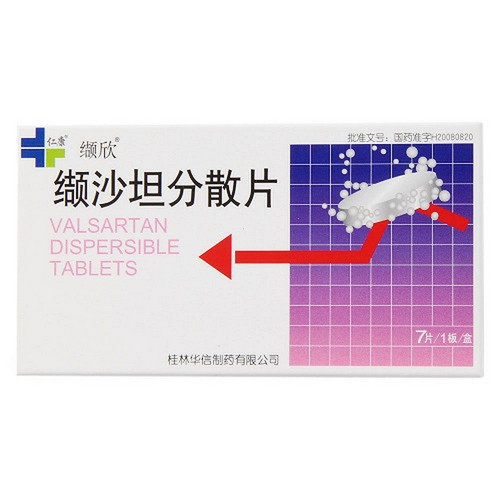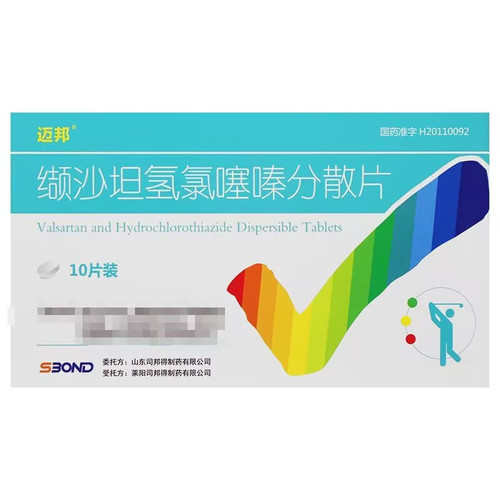Product Overview
[Drug Name]
Generic Name: Valsartan Dispersible Tablets
Trade Name: Wei Er Tan Zuo Sha Tan Fen San Pian
[Main Ingredient]
The main ingredient of this product is valsartan.
[Appearance]
This product is white tablets.
[Indications/Main Functions]
For the treatment of mild to moderate essential hypertension.
[Specifications]
80 mg x 7 tablets
[Dosage and Administration]
Recommended dose: 80 mg once daily. Dosage is not affected by race, age, or gender. It can be taken with or without food (see Absorption). It is recommended to take the drug at the same time each day (e.g., in the morning). A definitive antihypertensive effect is achieved within two weeks of treatment, and maximum efficacy is achieved after four weeks. If the antihypertensive effect is unsatisfactory, the daily dose can be increased to 160 mg, or a diuretic can be added. No dose adjustment is required for patients with renal impairment (contraindicated in severe renal failure) or non-biliary, non-cholestatic hepatic impairment. Valsartan can be used in combination with other antihypertensive drugs.
[Adverse Reactions]
Angioneurotic edema, rash, pruritus, and other hypersensitivity reactions such as serum sickness and vasculitis. Rarely, elevated liver function tests may be observed. Other adverse reactions with an incidence of less than 1% include edema, asthenia, insomnia, rash, and decreased libido. No specific laboratory parameters need to be monitored in patients with essential hypertension receiving valsartan.
[Contraindications]
Hypersensitivity to any component: Pregnancy (pregnancy and lactation); There is no experience with this product in patients with severe renal failure (creatinine clearance <10 mL/min).
[Drug Interactions]
No significant drug interactions have been observed clinically. Studies have been conducted with the following drugs: cimetidine, warfarin, furosemide, digoxin, atenolol, indomethacin, hydrochlorothiazide, amlodipine, and glyburide. Because valsartan undergoes minimal metabolism, no clinical interactions have been observed with drugs that induce valsartan dispersible tablets or inhibit the cytochrome P450 system. Although valsartan is largely bound to plasma proteins, in vitro studies have not demonstrated interactions at this level with other plasma protein-bound drugs (e.g., diclofenac, furosemide, and warfarin). When coadministered with potassium-sparing diuretics (e.g., spironolactone, triamterene, and amiloride), potassium supplementation or the use of potassium-containing preparations may increase serum potassium concentrations. Therefore, caution is advised when administering these drugs together.
[Precautions]
1. Hyponatremia and/or Volume Depletion: Rarely, patients with severe sodium and/or volume depletion (e.g., those taking high-dose diuretics) may experience symptomatic hypotension when starting treatment with this drug. Prior to starting treatment, correct the hyponatremia and/or volume depletion, or reduce the diuretic dose. If hypotension occurs, the patient should be placed in a supine position and, if necessary, receive intravenous saline. Treatment with this drug should be resumed after blood pressure stabilizes. 2. Renal Artery Stenosis: 4-day use of this drug in 12 patients with secondary renovascular hypertension due to unilateral renal artery stenosis did not cause significant changes in renal hemodynamics, creatinine, or blood urea nitrogen (BUN). Because other drugs that act on the RAAS may increase BUN and creatinine in patients with unilateral or bilateral renal artery stenosis, monitoring is recommended to ensure safety. 3. Renal Impairment: No dose adjustment is required for patients with renal impairment.
[Pediatric Use]
There is no experience with this drug in pediatric patients.
[Elderly Use]
Although systemic exposure to valsartan is slightly higher in the elderly than in younger patients, this is not clinically significant.
[Pharmacology and Toxicology]
Mechanism of Action: Angiotensin I is an activator of the renin-angiotensin-aldosterone system (RAAS). It is formed by angiotensin I in the presence of angiotensin-converting enzyme (ACE). Angiotensin I binds to specific receptors on the cell membranes of various tissues. It has multiple physiological effects, including direct or indirect involvement in blood pressure regulation. Angiotensin I is a potent vasoconstrictor with a direct pressor effect. It also promotes sodium reabsorption and stimulates aldosterone secretion. Valsartan is an orally effective, specific Angiotensin I (AT) receptor antagonist, it selectively acts on the AT1 receptor subtype, producing all known effects. The AT2 receptor subtype is not associated with cardiovascular effects. Pinasartan has no partial agonist activity at the AT1 receptor. Pinasartan has a 2000-fold stronger affinity for the AT1 receptor than for the AT2 receptor. ACE converts angiotensin I to angiotensin I and degrades bradykinin. Valsartan, an angiotensin I receptor antagonist, has no inhibitory effect on ACE and does not cause the retention of bradykinin or substance P, thus not causing cough. Clinical trials comparing valsartan and ACE inhibitors have shown that the incidence of dry cough in the valsartan group (2.6%) was significantly lower than that in the ACE inhibitor group (7.9%) (P<0.05). In a clinical trial of patients who developed dry cough symptoms after receiving ACE inhibitor treatment, 19.5%, 19.0%, and 68.5% of patients in the valsartan group, diuretic group, and ACEI group experienced cough, respectively (P<0.05). Valsartan has no effect on other hormone receptors or ion channels known to play an important role in cardiovascular regulation. Efficacy: Pinsartan lowers elevated blood pressure without affecting heart rate. In most patients, a single oral dose produces a blood pressure-lowering effect within 2 hours, reaching peak effect within 4-6 hours, and maintaining the effect for at least 24 hours after dosing. Maximum antihypertensive efficacy is achieved after 2-4 weeks of treatment and is maintained during long-term treatment. Combination with a thiazide diuretic can further significantly enhance the antihypertensive effect. Abrupt discontinuation of pinsartan treatment does not cause rebound hypertension or other side effects. Pinsartan does not affect total cholesterol, triglyceride, blood glucose, or uric acid levels in hypertensive patients.






